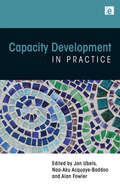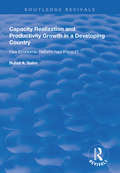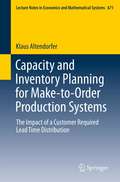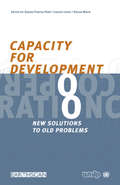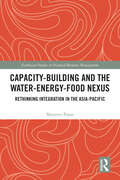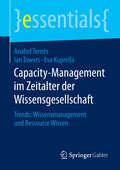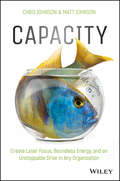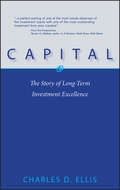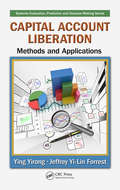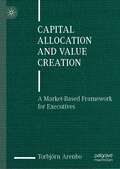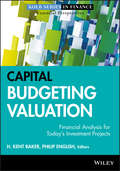- Table View
- List View
Capacity Building, Governance, and Economic Reform in Africa
by Roland E. Ubogu Michel A. DessartThe Joint African Institute was established by the African Development Bank, the IMF and the World Bank. This first seminar aimed to provide participants from multilateral institutions, the African public sector, and African academics, with a forum to discuss approaches to improving systems of governance and finding workable capacity-building solutions to Africa's economic development process.
Capacity Cost Rates: The Practical Issues
by Robert S. Kaplan Steven R. AndersonCalculating capacity cost rates is the second element in a time-driven activity-based costing model. This chapter discusses when to capture cost at a department or a process level, how to incorporate all relevant costs, and how to measure practical capacity.
Capacity Development in Practice
by Alan Fowler Jan Ubels Naa-Aku Acquaye-BaddooThe international development community invests billions of dollars to improve organisational capacity. But real-life practice is poorly understood and undervalued as a distinct professional domain. Written by practitioners, this innovative publication is designed to make capacity development more professional and increasingly effective in achieving development goals. Practical illustrations draw on experiences from the civic, government and private sectors. A central theme is to understand capacity as more than something internal to organisations. This book shows how capacity also stems from connections between different types of actor and the levels in society at which they operate. The content is crafted for a broad audience of practitioners in capacity development: consultants, managers, front-line workers, trainers, facilitators, leaders, advisors, programme staff, activists, and funding agencies. Published with SNV
Capacity Realization and Productivity Growth in a Developing Country: Has Economic Reform Had Impact? (Routledge Revivals)
by Ruhul A. SalimFirst published in 1999. Firms in manufacturing industries are influenced by the market-oriented liberalization reform policies in many developing countries since the late eighties. However, studies applying appropriate methodology to appropriate data seldom analyze the impact of reforms on the performance of production units such as manufacturing firms. The central point of this book is to address this issue by comparing firms’ achievement with 'best practice' performance before and after reforms. This form of analysis is not new but it emphasizes a new focus or realignment of thinking within neoclassical economics to develop an analytical framework. This book examines the productivity growth of Bangladesh manufacturing firms as component measures of changes in capacity realization and technical progress. The significant feature of this approach is that it allows for the inefficiency of firms, and thus productivity growth is estimated rather than taking it as a residual as is usually measured in the traditional growth accounting approach. High rates of technological progress, on the one hand, can co-exist with low rates of capacity realization. On the other hand, relatively low rates of technological progress can co-exist with an improving capacity realization. As a result specific policy actions are required to address the difference in the sources of variation in productivity. In this respect this book would provide invaluable insights for policy makers, development practitioners, academics and students of economics.
Capacity Withdrawals in the Electricity Wholesale Market: Between Competition Law and Regulation (Munich Studies on Innovation and Competition #7)
by Panagiotis TsangarisThis book examines the issue of capacity withdrawals in the electricity wholesale market. Electricity generators can exercise market power in the wholesale market either by withdrawing generation capacity, or by pricing above competitive levels in order to achieve a higher market price and, thereby, increase revenues. After a comprehensive explanation of capacity withdrawal practices and the issues that arise when proceeding under competition law, the book analyses whether an increased state of transparency, as provided for in the REMIT and Regulation 543/2013, could facilitate the efficient functioning of electricity wholesale markets and the investigation of capacity withdrawal practices. It also examines the effect of the prohibition of market manipulation as prescribed in the REMIT in dealing with abusive capacity withdrawals in the electricity wholesale market.
Capacity and Inventory Planning for Make-to-Order Production Systems: The Impact of a Customer Required Lead Time Distribution (Lecture Notes in Economics and Mathematical Systems #671)
by Klaus AltendorferThe book presents different models for the simultaneous optimization problem of capacity investment and work release rule parameterization. The overall costs are minimized either including backorder costs or considering a service level constraint. The available literature is extended with the integration of a distributed customer required lead time in addition to the actual demand distribution. Furthermore, an endogenous production lead time is introduced. Different models for make-to-order production systems with one or multiple serial processing stages are developed. Capacity investment is linked to the processing rates of the machines or to the number of the machines. Results are equations for service level, tardiness, and FGI lead time in such a production system. For special cases with M/M/1 and M/M/s queues explicit solutions of the optimization problems or optimality conditions concerning capacity investment and work release rule parameterization are provided.
Capacity for Development: New Solutions to Old Problems
by Carlos Lopes Sakiko Fukuda-Parr'The United Nations system was a pioneer in the field of technical cooperation, and capacity development is its central mandate. UNDP has long played an important leadership role in both, as a source of technical cooperation funds and advisory services and as the home of innovative intellectual research and analysis on how to make them more efficient and effective. This book [presents] a vision that builds on new possibilities for knowledge-sharing, for which the revolution in information and communications technologies offers ample opportunities... a vision that is firmly founded on genuine ownership by the ultimate beneficiaries of development efforts: the government and citizens of developing countries' From the Foreword by MARK MALLOCH BROWN, Administrator, UNDP Capacity for Development brings together innovative and well-supported studies of technical cooperation along with its potential to build sustainable capacities in developing countries, by enhancing the knowledge, skills and productive aptitudes of their populations. A team of eminent development professionals and economists examine the achievements of technical cooperation and offer recommendations for reform in the context of globalization, democratisation, the information revolution and the growth of capacities in the South. They analyse the issues from three perspectives: ownership, capacity enablers and knowledge. The team show how the complex processes involved can be restructured to produce local involvement and empowerment, set out a normative framework for the input from society, and describe a new paradigm of knowledge for capacity building in the network age. This book will be essential reading for all development professionals and policy-makers, as well as providing an invaluable research and teaching resource.
Capacity-Building and the Water-Energy-Food Nexus: Rethinking Integration in the Asia-Pacific (Earthscan Studies in Natural Resource Management)
by Maureen PapasCritically analysing methodologies and objectives of capacity building and the practical linkages required to achieve the Sustainable Development Goals, this book looks at whether nexus thinking offers a systematic approach to combat global environmental problems and facilitate enhanced sustainable development. Building effective and sustainable mechanisms to tackle environmental problems requires in-depth understanding of relationships between natural resources, going beyond conventional policy and siloed decision making. The water energy food nexus has been promoted as a conceptual framework and management tool to facilitate integrated planning and practical linkages to support sustainable development. The author opens this book with an overview of capacity building and reviews the significance of the water energy food nexus, bringing in links to the 2030 Agenda. Climate change is highlighted as a key consideration in any conversation about natural resource use and case studies from Japan, India and China are utilised to show that whist long-term sustainable development practices are being implemented the environmental challenges across the region raise concerns about institutional capacity, economic sustainability and future of the region. Finally, through the lens of capacity building, the book suggests that whilst the water energy food nexus may provide a new approach to sustainable development, it will not be enough to achieve long-term sustainability or extend to the lives of those most affected. The book will be interest to scholars and students within the water, energy and agriculture sectors, sustainability governance and sustainable development. It will also be a valuable resource to those working in governmental organisations and NGOs involved in capacity building and development.
Capacity-Management im Zeitalter der Wissensgesellschaft: Trends: Wissensmanagement und Ressource Wissen (essentials)
by Anabel Ternès Ian Towers Eva KuprellaDieses Essential gibt einen kompakten, aktuellen und praxisrelevanten Uberblick uber die Bedeutung des Megatrends Wissensgesellschaft. Die AutorInnen erlautern, welche Wissensmanagementwerkzeuge es gibt, und zeigen an Beispielen aus der Praxis, wie diese im Unternehmen eingesetzt werden. Zudem stellen sie Ergebnisse aus der Marktforschung zum Einsatz von Wissensmanagementmethoden vor und geben Handlungsempfehlungen fur Unternehmen, da Wissen als neue zentrale Ressource gerade in industrielastigen Landern ein grundsatzliches Umdenken in Unternehmen erfordert. "
Capacity: Create Laser Focus, Boundless Energy, and an Unstoppable Drive In Any Organization
by Chris Johnson Matt JohnsonOptimize your talent by removing the obstacles in their path Capacity is a proven system for bringing the best out of your team-and yourself. Matt and Chris Johnson set the mark on how to succeed in the future with their energizing message, humorous stories and their generational differences. As the world speeds-up faster and faster, organizations and their people try to keep up. This pressure to do more with less has reached epidemic levels of concern and organizations are panicking on how to recruit, retain and attract the best talent for the future. Burnout, low engagement, and overwhelming stress are jeopardizing organizations’ ability to scale and win. As outdated performance models of the past crumble under pressure, Matt and Chris show you how to build and protect your most valuable asset—YOUR PEOPLE. What if you could beat the clock and expand your capacity by 6 hours per week? Or 11? Think about the organizational impact if your workforce were given fresh capacity to perform, lead, and grow. This book offers a clear, workable solution for organizations functioning in the real world: by paring it down to three performance pillars they must have to succeed—focus, energy, and drive. Ever organization sets initiatives, but many remain unfinished because their capacity to do so fails before it starts. This framework is different: these changes bring the type of benefits that cause transformation. Giving your people what they need makes buy-in irrelevant, and allows them to perform at their highest potential. Not only can it work, but it is the only thing that will work over the long term. By making your organization a great place to work, you retain your best talent and attract more like it. With dedicated resources, focus, sustainable effort, and comprehensive strategy, your top performers will be equipped to drive your organization to the top. Among Capacity’s Key Points: Learn what top performers need to produce their very best work Discover the biggest factor influencing your team’s FOCUS, ENERGY and DRIVE Prevent burnout and stimulate innovation by allowing your people to have a bigger container Adopt a strategy of expanding capacity to exceed your high-performance goals Deeply personal, but organizational focused. Capacity is an engaging and even life changing book Capacity is the next big paradigm shift for the future of training and development—as we shift to the world of the knowledge worker, it is not information or talent that wins, it’s is whoever has the largest capacity that will win. Capacity is your secret weapon to winning the performance war.
Cape Verde: Selected Issues
by International Monetary FundA report from the International Monetary Fund.
Cape Wind: Offshore Wind Energy in the USA
by Richard H.K. VietorCape Wind is an extreme example of NIMBY--not in my backyard syndrome. This is the first offshore wind project planned for the United States, in Nantucket Sound, just south of Cape Cod, Massachusetts. Initially proposed six years ago, in 2001, the wind farm would be visible from Hyannis port and Osterville, two affluent communities. The coastal residents of those towns have led a campaign in Massachusetts and in Congress to thwart the efforts of Cape Wind. This case introduces the global wind industry, the rationale for wind, and then carefully reviews the various issues associated with the project.
Capi, Sciamani, Tiranni, Dittatori, Imperatori e Presidenti: Verso la comprensione matematica dei Gruppi Sociali
by Francesco dell'IsolaQuesto libro mette in luce alcune idee matematiche che aiutano a spiegare una serie di aspetti importanti della dinamica dei gruppi sociali. Le idee e le tecniche utilizzate sono analoghe a quelle che hanno avuto tanto successo nella descrizione del comportamento dei sistemi meccanici lagrangiani: questo libro si rivolge a chiunque voglia comprendere l'unità intrinseca dei fenomeni naturali.
Capire Ethereum e Blockchain: Una guida per principianti per iniziare a guadagnare
by Adidas WilsonSecondo alcuni, l’idea dell’Etherum è nata nel 2009, quando i Bitcoin diventarono la prima soluzione pratica di decentralizzazione. Senza dubbio, il successo della Blockchain ha influenzato moltissimo Vitalik Buterin, l’uomo dietro Ethereum. Ad ogni modo, il 2012 è poi stato un anno più particolare. In quell’anno Vitalik ha lasciato l’Università di Waterloo per girare il mondo partecipando a diverse innovazioni nel mondo delle criptovalute. Durante questo viaggio, Buterin ha concepito l’idea di Ethereum; una piattaforma criptoeconomica sicura per creare qualsiasi tipo di applicazione decentralizzata. Dopodichè, Vitalik ha iniziato a scrivere il Manifesto Ethereum. Il documento giustificava l’idea di una nuova cripto tecnologia, dichiarava i suoi principi più importanti e le possibili applicazioni. Il Manifesto è stato pubblicato nel 2013, e dopo un mese Buterin ha annunciato l’inizio del progetto Ethereum nel forum Bitcointalk. Nel suo post, Vitalik disse che stava lavorando con Jefrey Wilcke ed il dottor Gavin Wood come sviluppatori principali. Wood ha svolto il ruolo più importante nella creazione di Ethereum, dopo Vitalik. Il suo Foglio Giallo (la specificazione formale della Vitual Machine Ethereum) è stata pubblicata nell’Aprile 2014. Codificando la sua prima implementazione pratica in 7 linguaggi di programmazione, sviluppò il prototipo della piattaforma Ethereum. Proprio come Ethereum, Bitcoin si basa sulla tecnologia Blockchain, ma questo non significa nulla se non viene supportato dalla rete più potente della storia. Gli investitori hanno capitalizzato milioni di dollari in Bitcoin, usando il denaro per trading, dispositivi per il mining e tecnologie. Lanciare un network come quello richiedo la stessa quantità (se non maggiore) di fatica. Per formare un gruppo di investitori, minatori e sviluppatori, la fondaz
Capital
by Charles D. EllisGo inside the elite investment firm with Capital.The Capital Group is one of the world?s largest investment management organizations, but little is known about it because the company has shunned any type of publicity. This compelling book, for the first time, takes you inside one of the most elite and private investment firms out there?the Capital Group Companies?a value investment firm par excellence. It digs deeps to reveal the corporate culture and long-term investment strategies that have made Capital the one organization where most investment professionals would like to work and would most recommend as long-term investment managers for their family and friends.
Capital Account Convertibility
by Przemyslaw Gajdeczka Peter J. Quirk Owen Evans Vicente Galbis Arto Kovanen Alexander Kyei Dmitri Menchikov Roger Nord Mark O'Brien Laura Papi Susana Crossa de Sosa S. Kal Wajid Takashi YoshimuraThe paper summarizes the main issues arising from experiences of industrial and developing countries with capital account liberalization and it examines the IMF's treatment of capital controls in its surveillance, use of IMF resources, and technical assistance activities. Case studies of recent experiences with capital controls in Chile, Colombia, Malaysia, and Venezuela are presented.
Capital Account Liberalization
by International Monetary FundThis paper considers how capital markets in developing and transition economies can best be liberalised by reviewing the lessons learned from the experiences of advanced industrialised countries in opening up their capital markets in the years following the Second World War.
Capital Account Liberalization and Financial Sector Stability
by Karl Habermeier Jorge Iván Canales-Kriljenko Shogo Ishii Bernard Laurens John Leimone Judit VadaszThis paper analyses the links between capital account liberalisation and other policies influencing financial sector stability. Drawing on country experiences, it develops an operational framework for the co-ordination of capital account liberalisation, particularly with structural policies to strengthen the domestic financial system.
Capital Account Liberation: Methods and Applications (Systems Evaluation, Prediction, and Decision-Making)
by Ying Yirong Jeffrey Yi-Lin ForrestAlong with the development of economic globalization, many countries have begun to relax their controls on their capital accounts. However, the recent financial crises in Latin American countries as well as the exchange rate crises in Southeast Asian countries have shown that there is major risk associated with capital account liberalization.This b
Capital Allocation and Value Creation: A Market-Based Framework for Executives
by Torbjörn ArenboBy adopting a practical, market-oriented approach to capital allocation, this book sheds light on the complex issue of cash flow deployment and the creation of shareholder value. In order to run a company efficiently, it is not sufficient to simply be a competent businessperson. One must also possess the skills of a knowledgeable investor. The management must determine where to invest capital given the diverse range of investment options available, such as mergers and acquisitions (M&A), dividends, share repurchase programs, and organic growth opportunities. This book provides a useful analytical framework for corporate executives to consider when allocating capital, along with empirical findings from peer group studies and company case studies. The book helps answer the following questions: · What are the primary factors that drive your company's shareholder value? Are they aligned with the strategy the company is pursuing? · What are the key dynamics and trade-offs between return on investments (ROIC), growth, and earnings quality? · What are the current market expectations embedded in the stock price? · Given the capital allocation priorities, what does an “optimal” capital structure look like? · How do you set, and in turn communicate, the capital allocation and funding priorities? Written by an expert with more than 25 years of experience, this book helps business executives improve their skills as capital allocators by better understanding the financial markets.
Capital Allocation at HCA
by W. Carl Kester Emily R. McCombIn early 2017, HCA Holdings, an investor-owned hospital management company, faced a strategically important capital allocation decision. After the exit of its private equity sponsors in 2016, HCA had to determine how best to allocate its substantial annual free cash flows among several competing alternatives. Equity analysts and some mutual fund investors were clamoring for the company to initiate regular quarterly dividends, while some other hedge fund investors were eager to see more share repurchases. Other choices being advocated by various parties included reducing leverage to improve HCA's credit rating to investment grade, spurring growth by initiating a major acquisition program or reinvesting heavily in existing markets to enhance HCA's strong competitive position. These choices had to be made in the face of uncertainty about the future of healthcare regulation and tax policy following the 2016 U.S. presidential election, and in the context of its closest publicly traded peers struggling with heavy debt burdens. HCA's capital allocation choices would be crucial to its ability to provide high quality health care to patients, implement its corporate strategy and deliver value to shareholders.
Capital Asset Management: TOOLS AND STRATEGIES FOR DECISION MAKING
by Federal Facilities CouncilInformation on Capital Asset Management
Capital Budgeting
by Steve Harrison Don Dayananda Richard Irons John Herbohn Patrick RowlandThis book for advanced students and professionals in management and finance explains the financial appraisal of capital budgeting projects. It develops basic concepts, principles and techniques and applies them to case studies in forestry, property and international investments. Resource constraints are introduced to the capital budgeting decisions with a variety of worked examples using linear programming techniques. All calculations are extensively supported by Excel workbooks on the Web, and end of chapter questions.
Capital Budgeting Valuation
by H. Kent Baker Philip EnglishAn essential guide to valuation techniques and financial analysis With the collapse of the economy and financial systems, many institutions are reevaluating what they are willing to spend money on. Project valuation is key to both cost effectiveness measures and shareholder value. The purpose of this book is to provide a comprehensive examination of critical capital budgeting topics. Coverage extends from discussing basic concepts, principles, and techniques to their application to increasingly complex, real-world situations. Throughout, the book emphasizes how financially sound capital budgeting facilitates the process of value creation and discusses why various theories make sense and how firms can use them to solve problems and create wealth. Offers a strategic focus on the application of various techniques and approaches related to a firm's overall strategy Provides coverage of international topics based on the premise that managers should view business from a global perspective Emphasizes the importance of using real options Comprised of contributed chapters from both experienced professionals and academics, Capital Budgeting Valuation offers a variety of perspectives and a rich interplay of ideas related to this important financial discipline.
Capital Budgeting: Discounted Cash Flow Analysis
by Thomas R. PiperThis exercise comprises seven problems that collectively allow students to work through each type of cash flow that is encountered in capital budgeting. The instructor can also address such issues as product cannibalization and real options.

